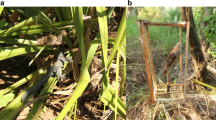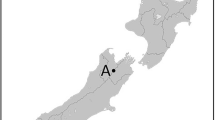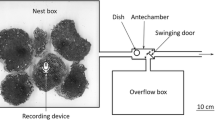Abstract
When helpers from cooperative breeding animals have some expectation of direct reproduction, there is potential for conflict over how much aid they should provide to the colony. For example, if food is shared among all colony members, then higher levels of foraging by a helper would be desirable for the colony as a whole. However, because foraging is risky and physiologically costly, hopeful reproductive helpers could avoid foraging. Evidence suggests that this work-conflict could be resolved if helpers are aggressively coerced by their nestmates to provide aid. Here, we showed that in the primitively eusocial paper wasp Polistes versicolor, colony food starvation leads to an increasing in aggression that results in an increasing activity level (including foraging). We propose that aggression affects forage levels because (i) attacks from nestmates are directed toward known foragers rather than non-foragers; and (ii) resting wasps generally respond to aggression by becoming more active while already active wasps generally respond by switching the task they were doing. In P. versicolor, direct reproduction is an option for helpers. It means that they can be considered as hopeful reproductive individuals seeking to avoid performing risky behaviours, like foraging. In this sense, decentralized aggression from nestmates could be a coercive mechanism to force wasps performing undesirable tasks, while simultaneously enhancing the performance of a variety of other tasks.






Similar content being viewed by others
References
Balshine-Earn S, Neat FC, Reid H, Taborsky M (1998) Paying to stay or paying to breed? Field evidence for direct benefits of helping behavior in a cooperatively breeding fish. Behav Ecol 9:432–438
Beekman M, Dussutour A (2009) How to tell your mates: costs and benefits of different recruitment mechanisms. In: Jarau S, Hrncir M (eds) Food exploitation by social insects: ecological, behavioral and theoretical approaches. CRC Press, Boca Raton, pp 115–134
Boomsma JJ, Grafen A (1991) Colony-level sex ratio selection in the eusocial hymenoptera. J Evol Biol 3:383–407
Bruyndonckx N, Kardile SP, Gadagkar R (2006) Dominance behaviour and regulation of foraging in the primitively eusocial wasp Ropalidia marginata (Lep.) (hymenoptera: Vespidae). Behav Process 72:100–103
Cant MA (2011) The role of threats in animal cooperation. Proc R Soc Lond B 278:170–178
Cant MA, Johnstone RA (2009) How threats influence the evolutionary resolution of within-group conflict. Am Nat 173:759–771
Cao TT, Hyland KM, Malechuk A, Lewis LA, Schneider SS (2009) The influence of the vibration signal on worker interactions with the nest and nest mates in established and newly founded colonies of the honey bee, Apis mellifera. Insect Soc 54:144–149
Clutton-Brock TH, Parker GA (1995) Punishment in animal societies. Nature 373:209–216
Crozier RH, Pamilo P (1996) Evolution of social insect colonies: sex allocation and kin selection. University Press, Oxford
Dani FR (1994) Caste size differences in Polistes gallicus (L.) (Hymenoptera Vespidae). Ethol Ecol Evol 6:67–73
Deneubourg JL, Aron S, Goss SAPJM, Pasteels JM, Duerinck G (1986) Random behaviour, amplification processes and number of participants: how they contribute to the foraging properties of ants. Physica D: nonlinear phenomena 22:176–186
De Souza AR, Prezoto F (2012a) Regulation of worker activity in the social wasp Polistes versicolor. Insect Soc 59:193–199
De Souza AR, Prezoto F (2012b) Aggressive interactions for a decentralized regulation of foraging activity in the social wasp Polistes versicolor. Insect Soc 59:463–467
De Souza AR, Ribeiro B, José N, Prezoto F (2012) Paint marking social wasps: an evaluation of behavioral effects and toxicity. Entomol Exp Appl 144:244–247
De Souza AR, Rodrigues IL, Rocha JVA, Reis WAA, Lopes JF, Prezoto F (2008) Foraging behavior and dominance hierarchy in colonies of the neotropical social wasp Polistes ferreri (Hymenoptera, Vespidae) in different stages of development. Sociobiology 52:293–303
Elisei T, Ribeiro-Junior C, Fernandes-Junior AJ, Nunes JC, De Souza AR, Prezoto F (2012) Management of Social Wasp Colonies in eucalyptus plantations (hymenoptera:Vespidae). Sociobiology 59:1–8
Gadagkar R (2001) The social biology of Ropalidia marginata: toward understanding the evolution of eusociality. Harvard University Press, Cambridge
Gobbi N, Noll FB, Penna MAH (2006) “Winter” aggregations, colony cycle, and seasonal phenotypic change in the paper wasp Polistes versicolor in subtropical Brazil. Naturwissenschaften 93:487–494
Hamilton WD (1972) Altruism and related phenomena, mainly in social insects. Annu Rev Ecol Syst 3:193–232
Hrncir M, Mateus S, Nascimento FS (2007) Exploitation of carbohydrate food sources in Polybia occidentalis: social cues influence foraging decisions in swarm-founding wasps. Behav Ecol Sociobiol 61:975–983
Hughes CR, Strassmann JE (1988) Age is more important than size in determining dominance among workers in the primitively eusocial wasp, Polistes instabilis. Behaviour 107:1–14
Itô Y (1985) A comparison of frequency of intra-colony aggressive behaviours among five species of polistine wasps (hymenoptera:Vespidae). Z Tierpsychol 68:152–167
Jacobs DS, Jarvis JUM (1996) No evidence for the work- conflict hypothesis in the eusocial naked mole-rat (Heterocephalus glaber). Behav Ecol Sociobiol 39:401–409
Jandt JM, Jeanne RL (2005) German yellowjacket (Vespula germanica) foragers use odors inside the nest to find carbohydrate food sources. Ethology 111:641–651
Jandt JM, Tibbetts EA, Toth AL (2014) Polistes paper wasps: a model genus for the study of social dominance hierarchies. Insect Soc 61:11–27
Jeanne RL, Taylor J (2009) Individual and social foraging in social wasps. In: Jarau S, Hrncir M (eds) Food exploitation in social insects: ecological, behavioral and theoretical approaches. CRC Press, Boca Raton, pp 223–249
Jeanne RL, Hunt JH, Keeping MG (1995) Foraging in social wasps: Agelaia lacks recruitment to food (hymenoptera: Vespidae). J Kansas Entomol Soc 68:279–289
Jha S, Casey-Ford R, Pedersen JS, Platt TG, Cervo R, Queller DC, Strassmann J (2006) The queen is not a pacemaker in the small-colony wasps Polistes instabilis and P. dominulus. Anim Behav 71:1197–1203
Lamba S, Chandrasekhar K, Gadagkar R (2008) Signaling hunger through aggression - the regulation of foraging in a primitively eusocial wasp. Naturwissenschaften 95:677–680
Lewis LA, Schneider SS, De Grandi-Hoffman G (2002) Factors influencing the selection of recipients by workers performing vibration signals in colonies of the honeybee, Apis mellifera. Anim Behav 63:361–367
Marôco J (2011) Análise estatística com o SPSS Statistics. ReportNumber, Lda
Miyano S (1986) Colony development, worker behavior and male production in orphan colonies of a Japanese paper wasp, Polistes chinensis antennalis Pérez (hymenoptera: Vespidae). Res Popul Ecol 28:347–361
Molina Y, O’Donnell S (2009) Worker reproductive competition affects division of labor in a primitively social paperwasp (Polistes instabilis). Insect Soc 56:4–20
Mulder RA, Langmore NE (1993) Dominant males punish helpers for temporary defection in superb fairy-wren. Anim Behav 45:830–833
Nagamati KJ, Simokomaki K, Gruber CV, Del-Lama MA (2010) Sociogenetic structure of Polistes (Aphanilopterus) versicolor Olivier, 1791 colonies (hymenoptera, Vespidae, Polistini). Genet Mol Biol 33:669–675
Nieh JC (1998) The honey bee shaking signal: function and design of a modulatory communication signal. Behav Ecol Sociobiol 42:23–36
O’Donnell S (1998) Effects of experimental foraging removals on division of labor in the primitively eusocial wasp Polistes instabilis (hymenoptera: Vespidae). Behaviour 135:17–193
O’Donnell S (2001) Worker biting interactions and task performance in swarm-founding eusocial wasp (Polybia occidentalis, hymenoptera: Vespidae). Behav Ecol 12:353–359
O’Donnell S, Bulova SJ (2007) Worker connectivity: are view of the design of worker communication systems and their effects on task performance in insect societies. Insect Soc 54:203–210
O’Donnell S, Jeanne RL (1992) Life-long patterns of forager behavior in a tropical swarm-founding wasp: effects of specialization and activity level on longevity. Anim Behav 44:1021–1027
O’Donnell S, Jeanne RL (1995) Worker lipid stores decrease with outside-nest task performance in wasps: implications for the evolution of age polyethism. Experientia 51:749–752
Oldroyd BP, Beekman M (2008) Effects of selection for honey bee worker reproduction on foraging traits. PLoS Biol 6:e56
Oliveira SA, Lopes JFS, Prezoto F (2006) Dominance hierarchy in different stages of development in colonies of the neotropical eusocial paper wasp Polistes versicolor hymenoptera, Vespidae. Sociobiology 48:515–526
Pamilo P (1991) Evolution of colony characteristics in social insects: I. Sex allocation. Am Nat 137:83–107
Pardi L (1948) Dominance order in Polistes wasps. Physiol Zool 21:1–13
Penick CA, Brent CS, Dolezal K, Leibig J (2014) Neurohormonal changes associated with ritualized combat and the formation of a reproductive hierarchy in the ant Harpegnathos salator. J Exp Biol 217:1496–1503
Pratt SC (1998) Condition-dependent timing of comb construction by honeybee colonies: how do workers know when to start building. Anim Behav 56:603–610
Pratt SC (2004) Collective control of the timing and type of comb construction by honey bees (Apis mellifera). Apidologie 35:193–205
Queller DC, Strassmann JE, Solis CR, Hughes CR, DeLoach DM (1993) A selfish strategy of social insect workers that promotes social cohesion. Nature 365:639–641
Ratnieks FL (1988) Reproductive harmony via mutual policing by workers in eusocial hymenoptera. Am Nat 132:217–236
Ratnieks FL, Reeve HK (1992) Conflict in single-queen hymenopteran societies: the structure of conflict and processes that reduce conflict in advanced eusocial species. J TheorBiol 158:33–65
Ratnieks FL, Wenseleers T (2008) Altruism in insect societies and beyond: voluntary or enforced? TREE 23:45–52
Ratnieks FL, Foster KR, Wenseleers T (2006) Conflict resolution in insect societies. Annu Rev Entomol 51:581–608
Reeve HK (1992) Queen activation in lazy workers in colonies of the eusocial naked mole-rat. Nature 358:147–149
Reeve HK, Gamboa GJ (1987) Queen regulation of worker foraging in paper wasps: a social feedback control system (Polistes fuscatus, hymenoptera: Vespidae). Behaviour 102:147–167
Richter MR (1990) Hunting social wasp interactions: influence of prey size, arrival order, and wasp species. Ecology 71:1018–1030
Santema P, Clutton-Brock T (2012) Dominant female meerkats do not use aggression to elevate work rates of helpers in response to increased brood demand. Anim Behav 83:827–832
Schneider SS, Lewis LA (2004) The vibration signal, modulatory commiunication and the organization of labor in honey bees, Apis mellifera. Apidologie 35:117–131
Schueller TI, Nordheim EV, Taylor BJ, Jeanne RL (2010) The cues have it; nest-based, cue-mediated recruitment to carbohydrate resources in a swarm-founding social wasp. Naturwissenschaften 97:1017–1022
Skaggs R, Jackson JC, Toth AL, Schneider SS (2014) The possible role of ritualized aggression in the vibration signal of the honeybee, Apis mellifera. Anim Behav 98:103–111
Strassmann JE (1981) Wasp reproduction and kin selection: reproductive competition and dominance hierarchies among Polistes annularis foundresses. Flor Entomol 64:74–88
Strassmann JE, Meyer DC (1983) Gerontocracy in the social wasp, Polistes exclamans. Anim Behav 31:431–438
Strassmann JE, Meyer DC, Matlock RL (1984) Behavioural castes in the social wasp, Polistes exclamans (hymenoptera: Vespidae). Sociobiology 8:211–224
Strassmann JE, Fortunato A, Cervo R, Turillazzi S, Damon JM, Queller DC (2004) The cost of queen loss in the social wasp Polistes dominulus (hymenoptera: Vespidae). J Kansas Entomol Soc 77:343–355
Sumana A, Starks PT (2004) The function of dart behavior in the paper wasp, Polistes fuscatus. Naturwissenschaften 91:220–223
Suzuki T (1985) Mating and laying of female-producing eggs by orphaned workers of a paper wasp, Polistes snelleni (hymenoptera: Vespidae). Ann Entomol Soc Am 78:736–739
Toth AL, Robinson GE (2005) Worker nutrition and division of labor in honeybees. Anim Behav 69:427–435
Trivers RL, Hare H (1976) Haplodiploidy and the evolution of the social insects. Science 191:249–263
van Doorn A (1987) Investigations into the regulation of dominance behaviour and the division of labor in bumblebee colonies (Bombus terrestris). Neth J Zool 37:255–276
West-Eberhard MJ (1969) The social biology of Polistinae wasps. Misc Publ Mus Zool Univ Mich 140:1–101
West-Eberhard MJ (1981) Intragroup selection and the evolution of insect societies. In: Alexander RD, Tinkle DW (eds) Natural selection and social behavior: recent research and new theory. Chiron, New York, pp 3–17
Wong M, Balshine S (2011) The evolution of cooperative breeding in the African cichlid fish, Neolamprologus pulcher. Biol Rev 86:511–530
Young AJ, Carlson AA, Clutton-Brock T (2005) Trade-offs between extraterritorial prospecting and helping in a cooperative mammal. Anim Behav 70:829–837
Acknowledgments
Authors are grateful to F Prezoto, BC Barbosa and BP Brugger for helping in field collections, to M Beekman for reviewing the early drafts of the manuscript, and two anonymous reviewers for the suggestions. Research was supported by Fundação de Amparo à Pesquisa do Estado de Minas Gerais (FAPEMIG), Conselho Nacional de Desenvolvimento Científico e Tecnológico (CNPq, proc. 143246/2011-9 to AR De Souza) and Fundação da Amparo à Pesquisa do Estado de São Paulo (FAPESP, proc. 2015/05302-0 to AR De Souza and proc. 2015/25301-9 to FS Nascimento).
Author information
Authors and Affiliations
Corresponding author
Electronic supplementary material
ESM 1
(XLS 57 kb)
Supplementary material S1
Aggressive bout in Polistes versicolor. The blue painted wasp displayed an aggressive sequence toward the orange painted one. After receiving aggression, the orange painted wasp left the colony. (WMV 5956 kb)
Rights and permissions
About this article
Cite this article
de Souza, A.R., Lino-Neto, J. & do Nascimento, F.S. Pushing Wasps to Work: Decentralized Aggression Induces Increased Activity in the Paper Wasp Polistes versicolor . J Insect Behav 30, 360–373 (2017). https://doi.org/10.1007/s10905-017-9624-2
Revised:
Accepted:
Published:
Issue Date:
DOI: https://doi.org/10.1007/s10905-017-9624-2




